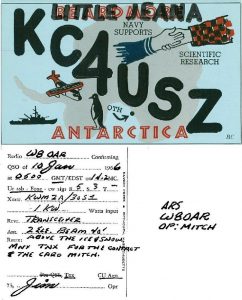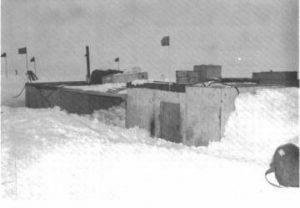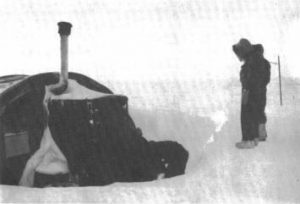 Sovetskaya , 77° 58’ South, 89° 16 East was a Soviet research station in Kaiser Wilhelm Land in Antarctica that was established on 16 February 1958 by the 3rd Soviet Antarctic Expedition on International Geophisic Year research work, and closed on 3 January 1959.
Sovetskaya , 77° 58’ South, 89° 16 East was a Soviet research station in Kaiser Wilhelm Land in Antarctica that was established on 16 February 1958 by the 3rd Soviet Antarctic Expedition on International Geophisic Year research work, and closed on 3 January 1959.
Antarctic Comrades (An American with the Russians in Antarctica) is a book written by Gilbert Dewart (https://core.ac.uk/download/pdf/159608932.pdf) . On it, Gilbert Dewart reports about a Sovietskaya Refuge (or Base) Here some paragraphs. We, have just add the WAP References for the sites mentioned:
… Another trail party left Mirnyy (WAP RUS-Ø7) that December: it took more fuel and supplies to Vostok, then returned to Komsomolskaya (WAP RUS-Ø5) and set out from there on a new heading in pursuit of the distant  Pole of inaccessibility (WAP RUS-NEW) –see pic aside to the right-.
Pole of inaccessibility (WAP RUS-NEW) –see pic aside to the right-.
Again the going was very tough, and with the season becoming dangerously late, the party pulled up at an intermediate spot on February 16, 1958, and opened Sovetskaya Station 11,700 feet above the sea. Though this position was unplanned, it was near enough to the goal, and for the scientific purpose of studying the extreme interior of the polar ice sheet it would serve as well. Six men wintered here under the leadership of V. K. Babarykin. Sovetskaya and Vostok stations both set new world records for low temperatures that winter, the final extreme minimum being-87.4° C (-125° F) at Vostok, so the Russians could now claim the “Pole of Cold.” With the three stations established on the ice plateau, plus Mirnyy, Pionerskaya, and Oazis, they now had six permanent bases in Antarctica for the second phase of the IGY in 1958. The Third Expedition, commanded by Ye. I. Tolstikov, operated this array of scientific stations.
 The site was occupied for only two weeks, until the official end of the IGY, then abandoned, though the shelters and basic equipment were left intact for future use.
The site was occupied for only two weeks, until the official end of the IGY, then abandoned, though the shelters and basic equipment were left intact for future use.
With the Fourth Expedition, directed by A. G. Dralkin, the Soviet Antarctic Program underwent retrenchment and a change in focus. The personnel complement was reduced from 185 to 113 men, and Sovetskaya (WAP RUS-NEW), Pionerskaya (WAP RUS-10), and Oazis (WAP RUS-NEW) were closed down in January
1959 (Oazis station was turned over to a small Polish contingent, but the Russo-Polish relationship proved acrimonious, and the Poles soon abandoned it).
Komsomolskaya was converted to seasonal use as a weather station and logistical support base for air operations in the summer. On the other hand, two thousand miles to the west, on the coast of Queen Maud Land, a landing party from the Ob established a new permanent station which was named, with history in mind again, for M. P. Lazarev, Bellingshausen’s second-in-command. Lazarev Station (WAP RUS-NEW) was intended as the base for an investigation of a nearby ice shelf and for an ambitious geological exploration program in a range of little-known mountains a short distance inland.
WAP have no evidence of any Hams that did ever operate HF from Sovetskaya Base, Lazarev and Oazis.
Thanks and credit to: Одинокий и холодный Ленин на «Полюсе недоступности» (фотогалерея) (rferl.org)

 Collins Refuge, 62º 10’ South, 58º 50’ 57” West, is an Antarctic shelter located in the Collins Glacier in the Collins Bay, Fildes Peninsula, King George Island.
Collins Refuge, 62º 10’ South, 58º 50’ 57” West, is an Antarctic shelter located in the Collins Glacier in the Collins Bay, Fildes Peninsula, King George Island. The Collins Refuge stands as one of the main housing supports on the ground for Antarctic work in Fildes Bay with a laboratory module as well as magnifying glasses and microscopes are available. A laboratory module as well as magnifying glasses and microscopes are available.
The Collins Refuge stands as one of the main housing supports on the ground for Antarctic work in Fildes Bay with a laboratory module as well as magnifying glasses and microscopes are available. A laboratory module as well as magnifying glasses and microscopes are available. The Center for Oldest Ice Exploration, or
The Center for Oldest Ice Exploration, or  Located at 62° 15’ South, 58° 59’ West on Nelson island the Refuge consists of a shipping container, flanked by two smaller containers. The main building contains several bunk-beds, a large amount of assorted bedding and blankets and a small store of water bottles, fruit juice and medicine.
Located at 62° 15’ South, 58° 59’ West on Nelson island the Refuge consists of a shipping container, flanked by two smaller containers. The main building contains several bunk-beds, a large amount of assorted bedding and blankets and a small store of water bottles, fruit juice and medicine. On last August 30, 2021, a ceremony was held at the facility of the Ministry of National
On last August 30, 2021, a ceremony was held at the facility of the Ministry of National  Defense. The Uruguayan Mail, following the request of the Uruguayan Antarctc Institute, presented a commemorative stamp, celebrating the 30th Anniversary of the first Antarctic naval mission aboard the ship “Pedro Campbell”
Defense. The Uruguayan Mail, following the request of the Uruguayan Antarctc Institute, presented a commemorative stamp, celebrating the 30th Anniversary of the first Antarctic naval mission aboard the ship “Pedro Campbell” Antarctic region, its use for exclusively peaceful purposes and transformation into a zone free of nuclear weapons.
Antarctic region, its use for exclusively peaceful purposes and transformation into a zone free of nuclear weapons. Russian Robinson Club together with SRR and HAMLOG.Online will issue a special award and plaque
Russian Robinson Club together with SRR and HAMLOG.Online will issue a special award and plaque WAP is happy to read that next 3YØJ Expedition to Bouvet Island ( Novem,ber 2022) will be set at Kapp (Cape) Fie, which site will enter for now, into the WAP Directory, as WAP NOR-New
WAP is happy to read that next 3YØJ Expedition to Bouvet Island ( Novem,ber 2022) will be set at Kapp (Cape) Fie, which site will enter for now, into the WAP Directory, as WAP NOR-New
 Dr Ruzica Dadic says there are complicated relationships between Antarctic snow and ice with feedback loops that need to be better understood as climate warms. The mysteries of how snow affects Antarctic sea ice remain largely unknown.
Dr Ruzica Dadic says there are complicated relationships between Antarctic snow and ice with feedback loops that need to be better understood as climate warms. The mysteries of how snow affects Antarctic sea ice remain largely unknown. Uruguayan Ionospheric Refuge 62°10′59.4′′ South, 58°54′31.6′′ West, takes its name by Ionospheric Lake Uruguay in its proximity. Recently an Uruguayan crew put their manual skills on full blast, and in a great teamwork. They refurbished the shelter located about 800 meters from the Artigas Antarctic Scientific Base (WAP URY-Ø1), which can be used in case of evacuation.
Uruguayan Ionospheric Refuge 62°10′59.4′′ South, 58°54′31.6′′ West, takes its name by Ionospheric Lake Uruguay in its proximity. Recently an Uruguayan crew put their manual skills on full blast, and in a great teamwork. They refurbished the shelter located about 800 meters from the Artigas Antarctic Scientific Base (WAP URY-Ø1), which can be used in case of evacuation.
 The design and build of the vessel has been a multi-national effort between the Australian Antarctic Division, the vessel operator Serco, Danish concept designers Knud E Hansen, Dutch engineering and detailed design team Damen, and the construction team at Damen Shipyards Galati in Romania.
The design and build of the vessel has been a multi-national effort between the Australian Antarctic Division, the vessel operator Serco, Danish concept designers Knud E Hansen, Dutch engineering and detailed design team Damen, and the construction team at Damen Shipyards Galati in Romania. Ukraina whose presence in Antarctica is dated 1995-1996, has followed the 6Ø ATS (AntarcticTreaty Signature) celebration, by putting a Special Event Station on the air.
Ukraina whose presence in Antarctica is dated 1995-1996, has followed the 6Ø ATS (AntarcticTreaty Signature) celebration, by putting a Special Event Station on the air. This is the second time that a UK research asset has transferred to Ukrainian research colleagues. The first being the transfer in 1996 of the former Faraday Station
This is the second time that a UK research asset has transferred to Ukrainian research colleagues. The first being the transfer in 1996 of the former Faraday Station  DS4NMJ Lee, Sanghoon is still active as DT8A from King Sejong a year-round station , one of the two Korean Bases in Antarctica where he will operate until December 31st , 2021.
DS4NMJ Lee, Sanghoon is still active as DT8A from King Sejong a year-round station , one of the two Korean Bases in Antarctica where he will operate until December 31st , 2021.
 There is a nice article published on last June 2021 by “Science Focus”.
There is a nice article published on last June 2021 by “Science Focus”. Day by day, several Hams from different nations are showing up with Special callsigns to join the 6Ø years Anniversary of the Antarctic Treaty Signature.
Day by day, several Hams from different nations are showing up with Special callsigns to join the 6Ø years Anniversary of the Antarctic Treaty Signature.
 D Q 6 Ø A N T
D Q 6 Ø A N T A small group of Enthusiastic USKA members (Union of Swiss Shortwave Radio Amateurs) will put the special call sign HB6ØANT, in support and reminder that this contract will be preserved, on the airwaves beginning in mid-August through December 31, 2021.
A small group of Enthusiastic USKA members (Union of Swiss Shortwave Radio Amateurs) will put the special call sign HB6ØANT, in support and reminder that this contract will be preserved, on the airwaves beginning in mid-August through December 31, 2021. It was not an easy task to retrace the history of Little Jeana Station but thanks to our friend Bill Ashley KF5BRB who did provide a QSL ofthis rare one, WAP is now in condition to issue to LITTLE JEANA STATION (aka Little Jeana Summer Weather Station) a brand new WAP reference as USA-47.
It was not an easy task to retrace the history of Little Jeana Station but thanks to our friend Bill Ashley KF5BRB who did provide a QSL ofthis rare one, WAP is now in condition to issue to LITTLE JEANA STATION (aka Little Jeana Summer Weather Station) a brand new WAP reference as USA-47. At the same time the station has been renamed “Little Jeana Summer Weather Station” and officially opened on 5 October 1964. The installation consists of 4 portable units, 3 of which are arranged in a “U”. In one are the sleeping and eating quarters for the 3-mandetach-ment; in another are a diesel generator and a workshop; while the third contains another generator and a wash room.
At the same time the station has been renamed “Little Jeana Summer Weather Station” and officially opened on 5 October 1964. The installation consists of 4 portable units, 3 of which are arranged in a “U”. In one are the sleeping and eating quarters for the 3-mandetach-ment; in another are a diesel generator and a workshop; while the third contains another generator and a wash room. Wintering-over party shovelling out the James-way but at Beardmore Summer Weather Station for activating the station. (29 September 1961.)
Wintering-over party shovelling out the James-way but at Beardmore Summer Weather Station for activating the station. (29 September 1961.) Observation Hill is also known for being the site where a Cross was erected as memorial to Robert Falcon Scott and his South Pole Party.
Observation Hill is also known for being the site where a Cross was erected as memorial to Robert Falcon Scott and his South Pole Party. This “brief life” Research site, was very singular! It was set on Pobeda Ice Island (original Russian name “Oстров Победы” aka Victory Island) in the Mawson Sea, about 160 km off the coast of Queen Mary Land, East Antarctca.
This “brief life” Research site, was very singular! It was set on Pobeda Ice Island (original Russian name “Oстров Победы” aka Victory Island) in the Mawson Sea, about 160 km off the coast of Queen Mary Land, East Antarctca. winter solstice in Antarctica, the crew at Concordia Research Station (WAP MNB-Ø3) are slowly welcoming the return of sunlight.
winter solstice in Antarctica, the crew at Concordia Research Station (WAP MNB-Ø3) are slowly welcoming the return of sunlight.  In a document sent to the Secretariat of the Antarctic Treaty
In a document sent to the Secretariat of the Antarctic Treaty  regarding the “Italian activities in Antarctica before the establishment of the PNRA” (and shown during the Consultative Meeting in Paris last June 2021) there is a paragraph concerning the expedition of
regarding the “Italian activities in Antarctica before the establishment of the PNRA” (and shown during the Consultative Meeting in Paris last June 2021) there is a paragraph concerning the expedition of  The largest and only independent Italian Antarctic Expedition was led by Renato Cepparo in 1976-77 to the South Shetland Islands by the Norwegian ship P/V Rig Mate.
The largest and only independent Italian Antarctic Expedition was led by Renato Cepparo in 1976-77 to the South Shetland Islands by the Norwegian ship P/V Rig Mate. The area still keeps the name Italia Valley.
The area still keeps the name Italia Valley. Remains of Giacomo Bove Station (Cepparo’s Team did operate HF radio using I1SR/P callsign)- Picture taken in 1998.
Remains of Giacomo Bove Station (Cepparo’s Team did operate HF radio using I1SR/P callsign)- Picture taken in 1998. Pic on the Left shows;
Pic on the Left shows;
 A real honor for me, for the relatives of Renato Cepparo and Giacomo Bove as well as for students, families, associations, partners and patrons. The Giacomo Bove and Maranzana (AT) Association and the Cultural Adri-Antartica Association, founders of the actually constituted National Consortium. All together, say thank you to all the supporters, to friends and families. Thanks to the late H.E. Ambassador Arduino Raimondo Fornara, yp Commander Gen. Amedeo Amedeo G. Cristofaro, to H.E. Ambassador Pier Francesco Zazo, graduated with prof. Silvio Zavatti.»
A real honor for me, for the relatives of Renato Cepparo and Giacomo Bove as well as for students, families, associations, partners and patrons. The Giacomo Bove and Maranzana (AT) Association and the Cultural Adri-Antartica Association, founders of the actually constituted National Consortium. All together, say thank you to all the supporters, to friends and families. Thanks to the late H.E. Ambassador Arduino Raimondo Fornara, yp Commander Gen. Amedeo Amedeo G. Cristofaro, to H.E. Ambassador Pier Francesco Zazo, graduated with prof. Silvio Zavatti.» McMurdo Station has no permanent residents — just a revolving door of visiting scientists and temporary personnel, some of whom live there for up to a year at a time. At its most populous, typically during the summer, it houses about 1,000 people.
McMurdo Station has no permanent residents — just a revolving door of visiting scientists and temporary personnel, some of whom live there for up to a year at a time. At its most populous, typically during the summer, it houses about 1,000 people. The Unión Glacier, located at 79º 46’ South, 83º 24’ West, is a large glacier converted since 2014 into the Base Camp.
The Unión Glacier, located at 79º 46’ South, 83º 24’ West, is a large glacier converted since 2014 into the Base Camp. In 2013 during the 68th Chilean Antarctic Campaign (ECA 50), the Polar Stations Arturo Parodi Alister (WAP CHL-14) –Picture here on the Right shows the entrance of Arturo Parodi Alister Base – established at Patriot Hills in 1996, and Antonio Huneeus Gana, were dismantled. Their equipments moved to the corridors of the future station, the Unión Glacier joint scientific polar station.
In 2013 during the 68th Chilean Antarctic Campaign (ECA 50), the Polar Stations Arturo Parodi Alister (WAP CHL-14) –Picture here on the Right shows the entrance of Arturo Parodi Alister Base – established at Patriot Hills in 1996, and Antonio Huneeus Gana, were dismantled. Their equipments moved to the corridors of the future station, the Unión Glacier joint scientific polar station.
 Japan will soon begin working toward construction of a new Antarctic base to continue with research into climate change over the past 1 million years.
Japan will soon begin working toward construction of a new Antarctic base to continue with research into climate change over the past 1 million years. Endurance22 will launch early next year with aim of locating and surveying wreck of Sir Ernest Shackleton’s ship Endurance in the Weddell Sea.
Endurance22 will launch early next year with aim of locating and surveying wreck of Sir Ernest Shackleton’s ship Endurance in the Weddell Sea. There is a very important person, leading expert of the Russian Antarctic Expedition of the Arctic and Antarctic Research Institute, one of the few people to receive the Order “For Naval Merit” (Russian: Орден «За морские заслуги»), a state decoration of the Russian Federation bestowed for excellence in military or economic maritime endeavours, Awarded for Excellence in worldwide oceanic activities in favour of Russian military and economic security.
There is a very important person, leading expert of the Russian Antarctic Expedition of the Arctic and Antarctic Research Institute, one of the few people to receive the Order “For Naval Merit” (Russian: Орден «За морские заслуги»), a state decoration of the Russian Federation bestowed for excellence in military or economic maritime endeavours, Awarded for Excellence in worldwide oceanic activities in favour of Russian military and economic security.



 Now climate change is undermining that success story. About 90% of the world’s surface fresh water is locked up in the Antarctic Ice Sheet and, as the planet heats up, glaciers whose collapse would deluge coastal cities from New York to Jakarta are melting and growing less stable.
Now climate change is undermining that success story. About 90% of the world’s surface fresh water is locked up in the Antarctic Ice Sheet and, as the planet heats up, glaciers whose collapse would deluge coastal cities from New York to Jakarta are melting and growing less stable. Asuka Station, located at 71°31’29’’South, 24°07’50’’East, altitude: 980.3mts was established in March, 1985 in Dronning Maud Land, 670 km southwest of Syowa Station (WAP JPN-Ø3).
Asuka Station, located at 71°31’29’’South, 24°07’50’’East, altitude: 980.3mts was established in March, 1985 in Dronning Maud Land, 670 km southwest of Syowa Station (WAP JPN-Ø3).
 Ice is thick in this particular region, and therefore extremely difficult to access. In 2012, the latest research vessel “Siras” could not even come close to the shore. Since that time, Japan was the country that lost the war, some thought that it had the unfortunate fate. However, as a result, this place was favorable for study and research.
Ice is thick in this particular region, and therefore extremely difficult to access. In 2012, the latest research vessel “Siras” could not even come close to the shore. Since that time, Japan was the country that lost the war, some thought that it had the unfortunate fate. However, as a result, this place was favorable for study and research. Gable Island (Isla Gable) is an Argentine island belonging to the Ushuaia Department of Tierra del Fuego Province of, Antarctica and the South Atlantic Islands in Argentina.
Gable Island (Isla Gable) is an Argentine island belonging to the Ushuaia Department of Tierra del Fuego Province of, Antarctica and the South Atlantic Islands in Argentina.
 The German Research Icebreaker Polarstern with the Call DPØPOL/MM (Op: Andreas, DL3LRM) will be active again in November/December 2021, still on time to join the 60th Anniversary of the Antarctic Treaty Signature. DPØPOL/MM will be
The German Research Icebreaker Polarstern with the Call DPØPOL/MM (Op: Andreas, DL3LRM) will be active again in November/December 2021, still on time to join the 60th Anniversary of the Antarctic Treaty Signature. DPØPOL/MM will be 
 Update your atlas: Southern Ocean recognised as world’s fifth ocean by Nat Geo cartographers
Update your atlas: Southern Ocean recognised as world’s fifth ocean by Nat Geo cartographers Bill Ashley KF5BRB has sent a very rare QSL of VP8CI, active from Royal Society Base built at 75° 31′ South, 26° 36′ at Halley Bay, West Weddell Sea on January 6th 1956
Bill Ashley KF5BRB has sent a very rare QSL of VP8CI, active from Royal Society Base built at 75° 31′ South, 26° 36′ at Halley Bay, West Weddell Sea on January 6th 1956

 The North Pole & South Pole – DX Trophy (NSP).
The North Pole & South Pole – DX Trophy (NSP). is excited to announce the world-renowned Polar exploration vessel formerly known as MS Hanseatic and Society Adventurer will be joining the fleet from May 2022.
is excited to announce the world-renowned Polar exploration vessel formerly known as MS Hanseatic and Society Adventurer will be joining the fleet from May 2022. Built in 1991 at Finland’s Rauma shipyard and specifically designed for Polar exploration, Heritage Adventurer is 124-metres long, boasts a 1A Super ice class and an impressive history of Polar and remote region exploration.
Built in 1991 at Finland’s Rauma shipyard and specifically designed for Polar exploration, Heritage Adventurer is 124-metres long, boasts a 1A Super ice class and an impressive history of Polar and remote region exploration. The Antarctic Treaty System (ATS) was entered into force in 1961. So this year it’s the 60th Anniversary.
The Antarctic Treaty System (ATS) was entered into force in 1961. So this year it’s the 60th Anniversary.  MARIST Archives & Special Collections has available a recording of an interview with Antarctic explorer Captain Finn Ronne from amateur radio station KC4USW, Weddel Sea, Antarctica, dated 1957, Nov.11.
MARIST Archives & Special Collections has available a recording of an interview with Antarctic explorer Captain Finn Ronne from amateur radio station KC4USW, Weddel Sea, Antarctica, dated 1957, Nov.11. (Ellsworth Mountains Camp mistakenly called Ellsworth Station) was built by US Navy Seabees under the command of Capt. Finn Ronne with the support of the Icebreackers USS Staten Island and USS Wyandot.
(Ellsworth Mountains Camp mistakenly called Ellsworth Station) was built by US Navy Seabees under the command of Capt. Finn Ronne with the support of the Icebreackers USS Staten Island and USS Wyandot. Feasibility of the station came into question when structural problems caused by the unstable ice had the base half-sunken during most of the spring. To protect personnel and equipment, Ellsworth Mountains Camp (mistakenly called Ellsworth Base) was closed and all of its staff and equipment were evacuated on 30 December 1962, during the 1962–63 Antarctic summer campaign. It continued to be inspected periodically by Argentinean exploration teams: it was eventually covered by snow and ice. The Filchner Shelf sector where it was located as split off a giant iceberg, and then it drifted through the Southern Ocean, where the base’s remains have been lost at sea.
Feasibility of the station came into question when structural problems caused by the unstable ice had the base half-sunken during most of the spring. To protect personnel and equipment, Ellsworth Mountains Camp (mistakenly called Ellsworth Base) was closed and all of its staff and equipment were evacuated on 30 December 1962, during the 1962–63 Antarctic summer campaign. It continued to be inspected periodically by Argentinean exploration teams: it was eventually covered by snow and ice. The Filchner Shelf sector where it was located as split off a giant iceberg, and then it drifted through the Southern Ocean, where the base’s remains have been lost at sea. A budget plan includes $344 million New Zealand dollars (US $247 million) to rebuild Scott Base
A budget plan includes $344 million New Zealand dollars (US $247 million) to rebuild Scott Base  Sad to recently learn that Andy Stillinger (WA2DKJ/KC4) died suddenly of natural causes this pass February 23, 2021
Sad to recently learn that Andy Stillinger (WA2DKJ/KC4) died suddenly of natural causes this pass February 23, 2021 the end of January in Antarctica operating from McMurdo Station (KC4USV)
the end of January in Antarctica operating from McMurdo Station (KC4USV)  Station “P” was a British base camp at the head of Mateev Cove on the east side of Hannah Point, 62°39’16”South, 60°36’48” West on Livingston Island in the South Shetland Islands, Antarctica that supported survey, geology and biology field work, from 29 December 1957 until 15 March 1958. It was a temporary, mobile camp for use by field parties on Livingston Island. It has not been the practice to assign letters to field camps, so the letter “P” was used as the intention had been to erect a Hut. RRS Shackleton was holed when transporting the Hut, parts of which were used to repair the ship.
Station “P” was a British base camp at the head of Mateev Cove on the east side of Hannah Point, 62°39’16”South, 60°36’48” West on Livingston Island in the South Shetland Islands, Antarctica that supported survey, geology and biology field work, from 29 December 1957 until 15 March 1958. It was a temporary, mobile camp for use by field parties on Livingston Island. It has not been the practice to assign letters to field camps, so the letter “P” was used as the intention had been to erect a Hut. RRS Shackleton was holed when transporting the Hut, parts of which were used to repair the ship.
 The Antarctic Treaty System is the whole complex of arrangements made for the purpose of regulating relations among states in the Antarctic. At its heart is the Antarctic Treaty itself. The original Parties to the Treaty were the 12 nations active in the Antarctic during the International Geophysical Year of 1957-58.
The Antarctic Treaty System is the whole complex of arrangements made for the purpose of regulating relations among states in the Antarctic. At its heart is the Antarctic Treaty itself. The original Parties to the Treaty were the 12 nations active in the Antarctic during the International Geophysical Year of 1957-58. Research led by the University of Kent’s School of Physical Sciences has found new evidence of a low-altitude meteoritic touchdown event reaching the Antarctic ice sheet 430,000 years ago.
Research led by the University of Kent’s School of Physical Sciences has found new evidence of a low-altitude meteoritic touchdown event reaching the Antarctic ice sheet 430,000 years ago.
 Rifugio Elefante is an Antarctic refuge located in the ice-free area at the foot of Fourcade glacier (62° 15’ 18″ South, 58° 37′ 56″ West) is located about 1000 mts from Punta Stranger,on the Potter peninsula of King George Island.
Rifugio Elefante is an Antarctic refuge located in the ice-free area at the foot of Fourcade glacier (62° 15’ 18″ South, 58° 37′ 56″ West) is located about 1000 mts from Punta Stranger,on the Potter peninsula of King George Island. stepped on the Antarctic, did install on the site, an autonomous system that would provide energy to the “Elephant Refuge” located 2.6 km northwest of Carlini Base (WAP ARG-2Ø) of the Argentine Antarctic Institute.
stepped on the Antarctic, did install on the site, an autonomous system that would provide energy to the “Elephant Refuge” located 2.6 km northwest of Carlini Base (WAP ARG-2Ø) of the Argentine Antarctic Institute. Sad news forwarded by Bhagwati VU3BPZ (8T2BH-AT1ØBPR).
Sad news forwarded by Bhagwati VU3BPZ (8T2BH-AT1ØBPR). Dr. Eddy De Busschere is the Secretary of the Belgian Polar Exploration Society (BPES).
Dr. Eddy De Busschere is the Secretary of the Belgian Polar Exploration Society (BPES).
 He said: « Jean Hooghewys OR4OR is no longer with us and I cannot contact his family to find out if any cards are left. It is the only card I am still missing from the Belgian Antarctic base 1957-1967. I think I have all the others. The only person that has such a card is Ghis Penny (ON5NT). May be there is someone able to offer me such a card. I keep my fingers crossed.
He said: « Jean Hooghewys OR4OR is no longer with us and I cannot contact his family to find out if any cards are left. It is the only card I am still missing from the Belgian Antarctic base 1957-1967. I think I have all the others. The only person that has such a card is Ghis Penny (ON5NT). May be there is someone able to offer me such a card. I keep my fingers crossed.
